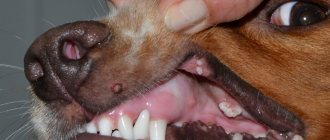In this article I will talk about epilepsy in dogs. I will describe the types of seizures and their causes, how they are diagnosed and treated, and how to care for a sick animal. I will explain what to do during an epileptic seizure in a pet and how to stop it. I will describe the possible consequences. I will give risk groups for epilepsy, symptoms and signs.
Epilepsy is a chronic neurological disease characterized by a dog's predisposition to sudden, uncontrolled seizures.
Types of epilepsy and causes
The main causes of seizures are:
Congenital defects in brain structures
These include:
- temporary deficiencies in GM nutrition during the period of intrauterine development, which leads to disturbances in the processes of excitation and inhibition in neurons;
- cerebellar pathologies;
- pathologies of the vestibular apparatus;
- diseases of the auditory nerve.
Acquired anomalies of central nervous system functioning
The reasons may be:
- Infections affecting the NS;
- intoxication of the body;
- traumatic brain injuries;
- exposure of an animal to electric current;
- unbalanced diet (lack of certain elements);
- poisonous insect bites;
- disruptions of the hormonal system;
- helminthiases;
- low blood glucose concentration;
- tumor neoplasms in brain structures.
Epilepsy is a consequence of a neurological disorder that occurs in the brain of an animal.
An epileptic seizure in a sick animal can be provoked by:
- severe stress;
- sudden sharp noise or flashes of light;
- overwork;
- sudden disruption of hormonal levels;
- strong emotions (fear, joy).
Epileptic seizures can be pronounced (all stages of the attack are clearly visible) or almost invisible.
In the second case (minor seizure or absence seizure), the animal may not pass out and fall to the floor. Loss of consciousness is short-lived, convulsions appear only in the limbs. The pet quickly comes to its senses. The first case will be described in more detail later in the article.
Can a dog die
Death from epilepsy occurs if an attack is accompanied by spontaneous cessation of breathing (asphyxia). During convulsions, the pet loses orientation in space, which leads to severe bruises and damage. In some cases, these injuries are not compatible with life. If the dog is not treated, the disease progresses. Seizures recur more often, are more severe, and last longer. For the body, this is severe stress, depleting the nervous and immune systems. After each subsequent attack, the animal weakens and may eventually die, unable to withstand the load.
Symptoms and signs
Epilepsy is diagnosed based on characteristic symptoms and laboratory tests. There is true and false (similar). A true epilepsy attack occurs in several stages:
- The appearance of warning signs of a seizure. The animal appears confused or scared. Trying to hide, find a secluded place. Avoids noise and bright light. Whines or howls. Salivation increases.
- Seizure. The pet falls to the floor and loses consciousness. The whole body is tense, the head is thrown back, the pupils dilate, and convulsions occur (twitching of the head and limbs). The pet is breathing loudly and frequently. Involuntary urination or bowel movements may occur. Foam is released from the mouth, and the animal may bite its tongue.
- Postictal stage. The animal regains consciousness. She looks confused. Disorientation in space and misrecognition of the owner are possible. Increased salivation. The dog may wander around the property for some time without finding a place.
Due to changes in neurological cells, uncontrolled, not typical for animals, arise.
Is it possible to stop seizures completely?
With true epilepsy, the dog is on medications for life. Remedies are selected by trial and error; unfortunately, there is no single medicine in a set dose that helps everyone without exception. They start with minimal doses and stop at the one that stops seizures. Usually, 2-3 types of anticonvulsants are used simultaneously if monotherapy is powerless.
You cannot change the dose or combination of drugs yourself; this leads to increased symptoms and does not exclude the death of your pet!
Sometimes positive aspects are observed in the treatment of secondary epilepsy, when the disease that provoked it is eliminated.
Any pet can get sick, but this does not mean that its life is over. Boundless love and participation will help the dog live with this disease for the years allotted to it by nature!
Diagnostics
Diagnosis of the disease in a veterinary clinic includes:
During diagnosis, it is necessary to establish the true cause of the disease: congenital or acquired.
And prescribe further treatment for the underlying cause. Idiopathic epilepsy in an animal
Seizure-like attacks (narcolepsy)
What is epilepsy
An epileptic dog is not a death sentence, although most owners prefer euthanasia to treatment. This is a purely personal decision. It is usually made by those who are afraid of the difficulties of keeping “problem” pets.
Depending on the cause of development, epilepsy takes over 40 forms. Examination does not always reveal the exact cause of the disease. There is a malfunction in the “electrical network” of the brain, and it is difficult to understand why the “short circuit” occurred.
What to do? Treat: carefully select medications that increase the time between attacks and follow the veterinarian’s recommendations regarding the content. Then the pets will successfully live out their dog’s lifespan – according to statistics, in 70% of cases.
What to do during an epileptic seizure
If an epileptic seizure occurs, the owner should:
An attack in a dog can begin and last up to half an hour.
If it lasts longer, it is necessary to urgently take the pet to a veterinary clinic for emergency medical care.
If the seizure lasted several minutes, you need to give the dog time to recover (completely return to its normal state), and only then take it to the doctor.
If a seizure occurs for the first time, the dog must be taken to the veterinarian.
If epilepsy is diagnosed, the specialist will prescribe competent treatment and prescribe medications to relieve subsequent attacks. He will explain how to properly and quickly cope with such situations at home.
Do not touch the animal's mouth and do not try to reach the tongue - the pet does not control itself and may bite you
Seizure prevention
It is difficult for the owner to exclude the occurrence of the disease, especially when it comes to genetic predisposition. Secondary epilepsy can result from injury, inadequate care, or disease. Caring for a pet from puppyhood and annual medical examination (examination by a doctor) is the prerogative of the breeder.
It must be remembered that in an epileptic dog, an attack can be caused by the slightest disturbance: you cannot scold the dog, leave it at home alone for a long time, or ignore it for the sake of another family member. The pet needs to be given maximum care and love!
Limit the amount of salty foods and meat products in your diet (not to be confused with “exclude completely”), add millet, legumes, carrots, cabbage.
The dog should lead a normal lifestyle; you should not make it a disabled person. Walks, games, trips and physical activity within reasonable limits, a positive attitude towards the pet of all family members is an indispensable basis for good health. Eliminate provoking factors!
Consequences and life expectancy in a dog
A complete cure for epilepsy is currently impossible. Therapy is prescribed to relieve and prevent further attacks.
With proper treatment, it is possible to significantly improve your pet's condition and reduce the occurrence of seizures to a minimum.
In case of illness, veterinarians prescribe sedative and anticonvulsant veterinary drugs: diazepam, phenytoin, primidone tablets, phenobarbital, tazepam, sodium bromide, hexamidine.
Self-treatment of epilepsy in a dog with medications is unacceptable.
Each product has a large number of side effects and can cause irreparable harm to the health of the animal.
The veterinarian prescribes the product based on the clinical picture of the disease, age and weight of the pet.
Epilepsy is not a fatal disease! But if you don't help your pet, the dog can die. By improving the quality of life of the pet and proper treatment, the dog will live a long, fulfilling life.
Epilepsy cannot be cured forever, but with the help of medications it is possible to minimize the risk of developing seizures
Treatment and first aid
If your dog has seizures similar to epilepsy, you must immediately contact a veterinary clinic, conduct an examination and find out the diagnosis. The owner must describe the attack in detail, indicate its duration, and the behavior of the pet. The disease cannot be completely cured, but with the help of special medications it is possible to maintain the normal condition of the dog, prolong its life and stop epileptic attacks.
Important! For epilepsy, lifelong drug therapy is prescribed. The selection of medication is carried out by a veterinarian based on side effects.
Diagnostic methods used for suspected epilepsy:
- electroencephalography (EEG) – detects and measures electrical impulses in the animal’s brain;
- X-ray of the skull – provides information about the presence of injuries, blood clots, neoplasms;
- magnetic resonance imaging (MRI) of the head - reveals lesions of the nervous system, dystrophic changes, impaired blood supply, tumors and inflammation.
First aid for a dog during an epileptic attack is to create conditions under which it cannot harm itself. It is important to ensure that breathing is free. To do this, the pet should be placed on its side and its head raised. In this position, vomit or saliva will not block the animal's airways. In hot weather, you can wipe the paws and belly with a damp cloth. It is necessary to call a veterinarian at home or take your pet to the clinic after the seizure is over. The first time the seizures last only 1-2 minutes. If they last more than 10 minutes, it becomes life-threatening for the animal and urgent medical attention is required.
Proper nutrition is an important aspect of a dog's well-being with epilepsy. Natural food should not contain salt or spices. It is better to give preference to protein products and grains. If your pet eats ready-made food, you should choose only those made on a dairy-vegetable basis. They are easier to digest and absorbed faster. Vitamins should be included in the diet periodically.
Reasons for development
The genetic form of the neurological disorder is inherited. The exact causes of brain cell damage have not been established.
The secondary form of the disease is a consequence of various factors that disrupt the functioning of the central nervous system. After 5 years of life, doctors diagnose an acquired type of epilepsy in dogs.
Causes of secondary epilepsy:
- intoxication after snake bites and acute food poisoning;
- skull injuries;
- metabolic problems;
- deficiency of minerals and vitamins;
- hypoglycemia (more often in older dogs);
- toxic damage to the body due to active reproduction of helminths and protozoa;
- brain tumors;
- chemical poisoning;
- development of severe kidney and liver damage;
- a complication against the background of dangerous diseases such as piroplasmosis, plague, rabies.











